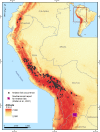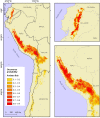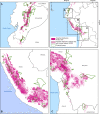The Andean Ibis (Theristicus branickii) in South America: potential distribution, presence in protected areas and anthropic threats
- PMID: 38099301
- PMCID: PMC10720468
- DOI: 10.7717/peerj.16533
The Andean Ibis (Theristicus branickii) in South America: potential distribution, presence in protected areas and anthropic threats
Abstract
The avifauna of South America is one of the most widely studied groups of vertebrates. However, certain species, such as the Andean Ibis (Theristicus branickii), have received limited attention regarding their ecological patterns, biology, current distribution, and environmental requirements. This study analyzed observation data from the Global Biodiversity Information Facility (GBIF) on the Andean Ibis in four countries to identify and understand critical variables that determine the species' presence, assess the proportion of its habitat within protected areas and identify possible threats to the species. Additionally, this study considered environmental and ecological variables to model ecological niches using the maximum entropy approach in MaxEnt to map the suitable habitat of the species. The findings revealed the extent of suitable Andean Ibis habitats in Ecuador, Peru, Bolivia and Chile. The variables that most determined the presence of the species were: altitude (36.57%), distance to lakes (23.29%) and ecological isothermality (13.34%). The distribution area of the Andean Ibis totaled 300,095.00 km2, spanning both sides of the Andean mountains range. Human activities have left a significant impact on the Andean Ibis habitat, with 48% of this area impacted by the human footprint and only 10% of the territory falling within protected areas designated by the respective countries. The results of this study show that the Andean Ibis presents characteristics of a specialist species due to its adaptation to the climate conditions of the plateau and highlands, including low temperatures, herbaceous vegetation and the presence of water bodies. The species is distributed in disconnected Andean landscape areas, whose functionality could be compromised by increased human activities. Complementary studies will be necessary to understand the ecological role and effectiveness of protected areas for conserving the species.
Keywords: Birds; Footprint; GBIF-data; MaxEnt; Niche Model.
©2023 Luzuriaga-Neira et al.
Conflict of interest statement
Roxana Rojas-VeraPinto, is employed by Isnache Project. Michaël André Jean Moens, was employed by Fundación de Conservación Jocotoco. José León is employed by Fundación de Conservación Jocotoco.
Figures




References
-
- Alcocer R. Master’s thesis. 2014. Nidificación, vigilancia del nido y éxito reproductivo de la bandurria andina Theristicus melanopis branickii Berlepsh & Stolzmann, 1894 (Threskiornithidae), en la localidad de Collpamayo, provincia de Espinar, Cusco 2013-2014.
-
- Anthelme F, Peyre G. Encyclopedia of the World’s Biomes. Amsterdam: Elsevier; 2020. Biogeography of South American highlands, in earth systems and environmental sciences; pp. 518–529. - DOI
MeSH terms
LinkOut - more resources
Full Text Sources

